Monopoly Pricing: Understanding Different Management Criteria
VerifiedAdded on 2023/04/21
|11
|2810
|447
AI Summary
This assignment explores the concept of monopoly pricing and its impact on different management criteria. It discusses the relationship between price, marginal revenue, and profit in a monopoly market. It also examines the effects of government regulation on monopoly pricing. The assignment provides detailed explanations and examples to support the concepts.
Contribute Materials
Your contribution can guide someone’s learning journey. Share your
documents today.
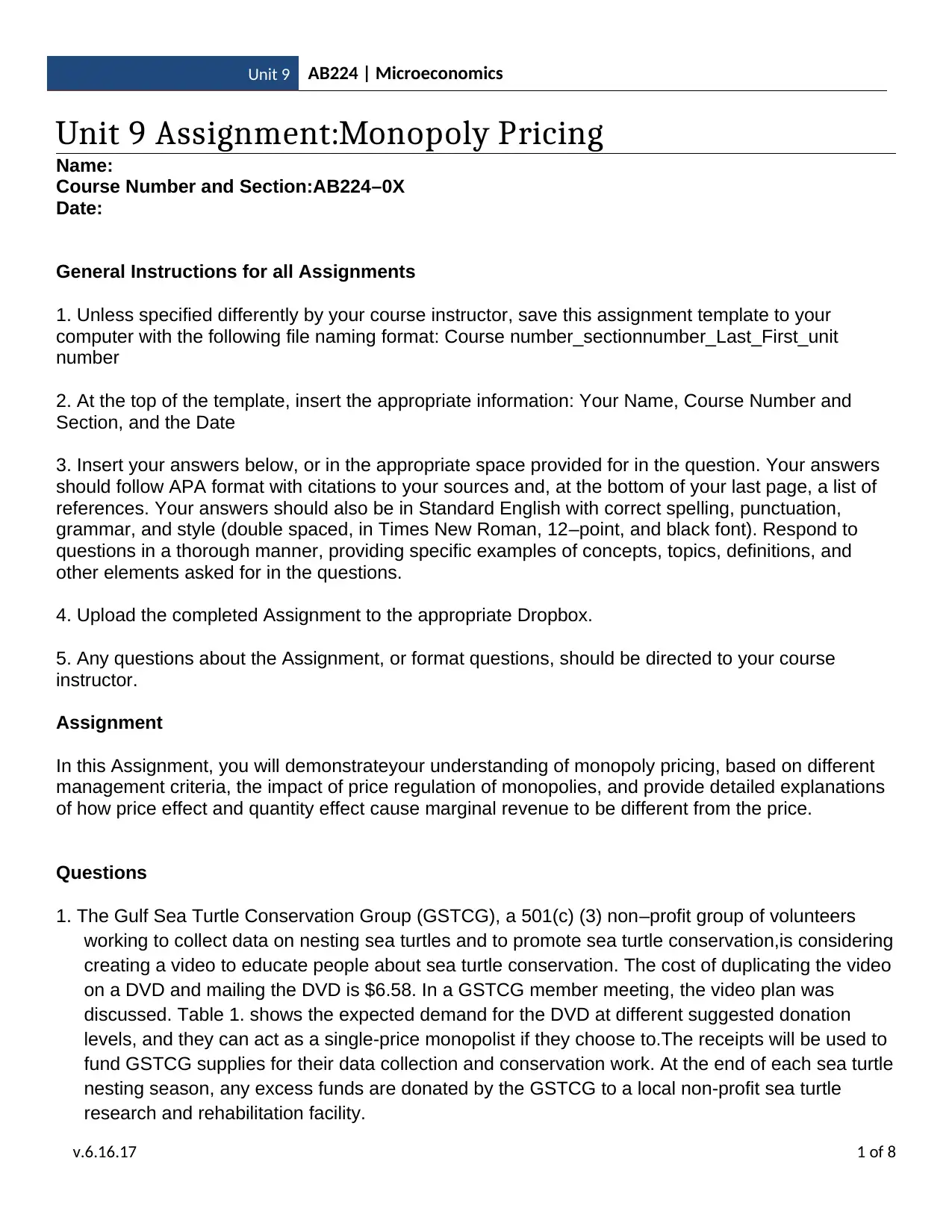
Unit 9 AB224 | Microeconomics
Unit 9 Assignment:Monopoly Pricing
Name:
Course Number and Section:AB224–0X
Date:
General Instructions for all Assignments
1. Unless specified differently by your course instructor, save this assignment template to your
computer with the following file naming format: Course number_sectionnumber_Last_First_unit
number
2. At the top of the template, insert the appropriate information: Your Name, Course Number and
Section, and the Date
3. Insert your answers below, or in the appropriate space provided for in the question. Your answers
should follow APA format with citations to your sources and, at the bottom of your last page, a list of
references. Your answers should also be in Standard English with correct spelling, punctuation,
grammar, and style (double spaced, in Times New Roman, 12–point, and black font). Respond to
questions in a thorough manner, providing specific examples of concepts, topics, definitions, and
other elements asked for in the questions.
4. Upload the completed Assignment to the appropriate Dropbox.
5. Any questions about the Assignment, or format questions, should be directed to your course
instructor.
Assignment
In this Assignment, you will demonstrateyour understanding of monopoly pricing, based on different
management criteria, the impact of price regulation of monopolies, and provide detailed explanations
of how price effect and quantity effect cause marginal revenue to be different from the price.
Questions
1. The Gulf Sea Turtle Conservation Group (GSTCG), a 501(c) (3) non–profit group of volunteers
working to collect data on nesting sea turtles and to promote sea turtle conservation,is considering
creating a video to educate people about sea turtle conservation. The cost of duplicating the video
on a DVD and mailing the DVD is $6.58. In a GSTCG member meeting, the video plan was
discussed. Table 1. shows the expected demand for the DVD at different suggested donation
levels, and they can act as a single-price monopolist if they choose to.The receipts will be used to
fund GSTCG supplies for their data collection and conservation work. At the end of each sea turtle
nesting season, any excess funds are donated by the GSTCG to a local non-profit sea turtle
research and rehabilitation facility.
v.6.16.17 1 of 8
Unit 9 Assignment:Monopoly Pricing
Name:
Course Number and Section:AB224–0X
Date:
General Instructions for all Assignments
1. Unless specified differently by your course instructor, save this assignment template to your
computer with the following file naming format: Course number_sectionnumber_Last_First_unit
number
2. At the top of the template, insert the appropriate information: Your Name, Course Number and
Section, and the Date
3. Insert your answers below, or in the appropriate space provided for in the question. Your answers
should follow APA format with citations to your sources and, at the bottom of your last page, a list of
references. Your answers should also be in Standard English with correct spelling, punctuation,
grammar, and style (double spaced, in Times New Roman, 12–point, and black font). Respond to
questions in a thorough manner, providing specific examples of concepts, topics, definitions, and
other elements asked for in the questions.
4. Upload the completed Assignment to the appropriate Dropbox.
5. Any questions about the Assignment, or format questions, should be directed to your course
instructor.
Assignment
In this Assignment, you will demonstrateyour understanding of monopoly pricing, based on different
management criteria, the impact of price regulation of monopolies, and provide detailed explanations
of how price effect and quantity effect cause marginal revenue to be different from the price.
Questions
1. The Gulf Sea Turtle Conservation Group (GSTCG), a 501(c) (3) non–profit group of volunteers
working to collect data on nesting sea turtles and to promote sea turtle conservation,is considering
creating a video to educate people about sea turtle conservation. The cost of duplicating the video
on a DVD and mailing the DVD is $6.58. In a GSTCG member meeting, the video plan was
discussed. Table 1. shows the expected demand for the DVD at different suggested donation
levels, and they can act as a single-price monopolist if they choose to.The receipts will be used to
fund GSTCG supplies for their data collection and conservation work. At the end of each sea turtle
nesting season, any excess funds are donated by the GSTCG to a local non-profit sea turtle
research and rehabilitation facility.
v.6.16.17 1 of 8
Secure Best Marks with AI Grader
Need help grading? Try our AI Grader for instant feedback on your assignments.
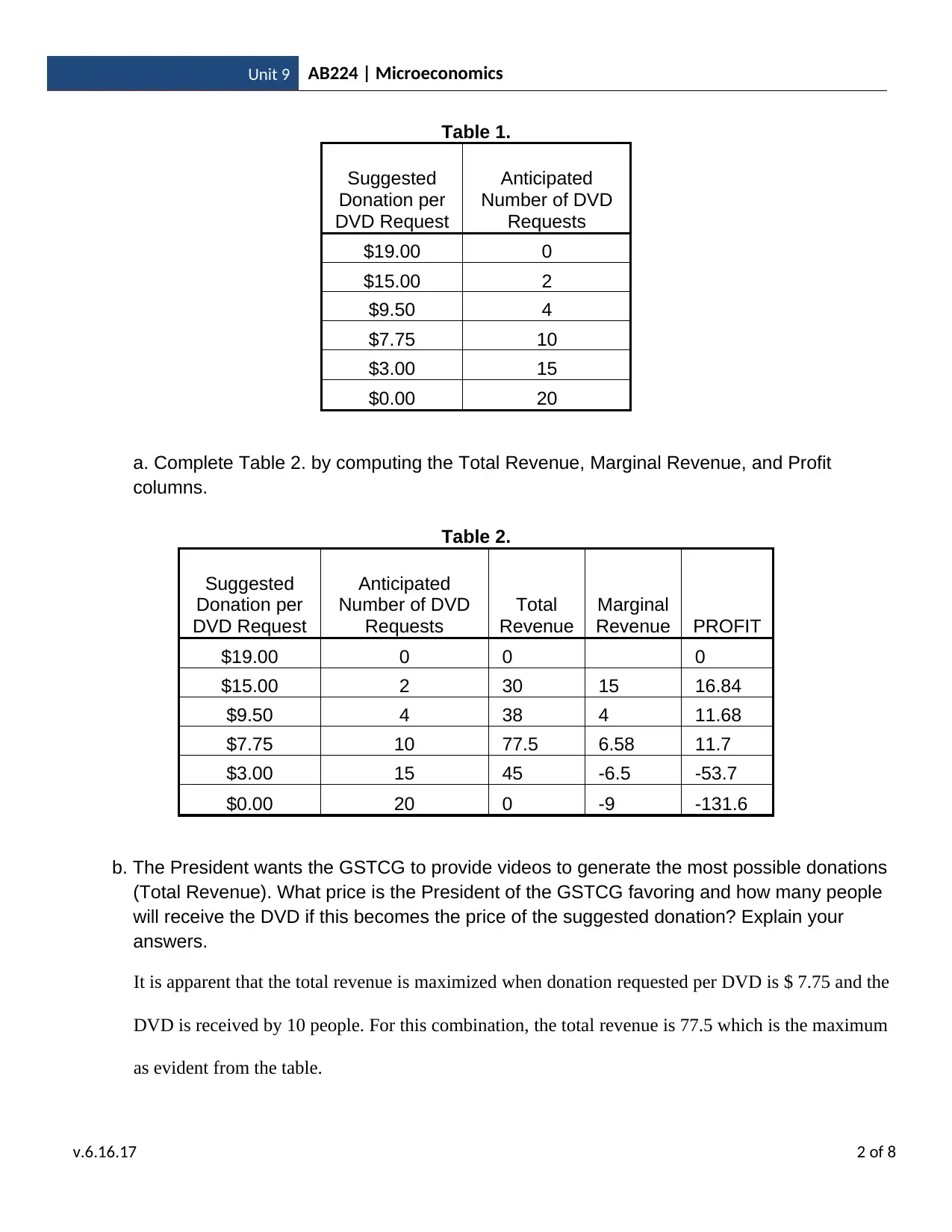
Unit 9 AB224 | Microeconomics
Table 1.
Suggested
Donation per
DVD Request
Anticipated
Number of DVD
Requests
$19.00 0
$15.00 2
$9.50 4
$7.75 10
$3.00 15
$0.00 20
a. Complete Table 2. by computing the Total Revenue, Marginal Revenue, and Profit
columns.
Table 2.
Suggested
Donation per
DVD Request
Anticipated
Number of DVD
Requests
Total
Revenue
Marginal
Revenue PROFIT
$19.00 0 0 0
$15.00 2 30 15 16.84
$9.50 4 38 4 11.68
$7.75 10 77.5 6.58 11.7
$3.00 15 45 -6.5 -53.7
$0.00 20 0 -9 -131.6
b. The President wants the GSTCG to provide videos to generate the most possible donations
(Total Revenue). What price is the President of the GSTCG favoring and how many people
will receive the DVD if this becomes the price of the suggested donation? Explain your
answers.
It is apparent that the total revenue is maximized when donation requested per DVD is $ 7.75 and the
DVD is received by 10 people. For this combination, the total revenue is 77.5 which is the maximum
as evident from the table.
v.6.16.17 2 of 8
Table 1.
Suggested
Donation per
DVD Request
Anticipated
Number of DVD
Requests
$19.00 0
$15.00 2
$9.50 4
$7.75 10
$3.00 15
$0.00 20
a. Complete Table 2. by computing the Total Revenue, Marginal Revenue, and Profit
columns.
Table 2.
Suggested
Donation per
DVD Request
Anticipated
Number of DVD
Requests
Total
Revenue
Marginal
Revenue PROFIT
$19.00 0 0 0
$15.00 2 30 15 16.84
$9.50 4 38 4 11.68
$7.75 10 77.5 6.58 11.7
$3.00 15 45 -6.5 -53.7
$0.00 20 0 -9 -131.6
b. The President wants the GSTCG to provide videos to generate the most possible donations
(Total Revenue). What price is the President of the GSTCG favoring and how many people
will receive the DVD if this becomes the price of the suggested donation? Explain your
answers.
It is apparent that the total revenue is maximized when donation requested per DVD is $ 7.75 and the
DVD is received by 10 people. For this combination, the total revenue is 77.5 which is the maximum
as evident from the table.
v.6.16.17 2 of 8
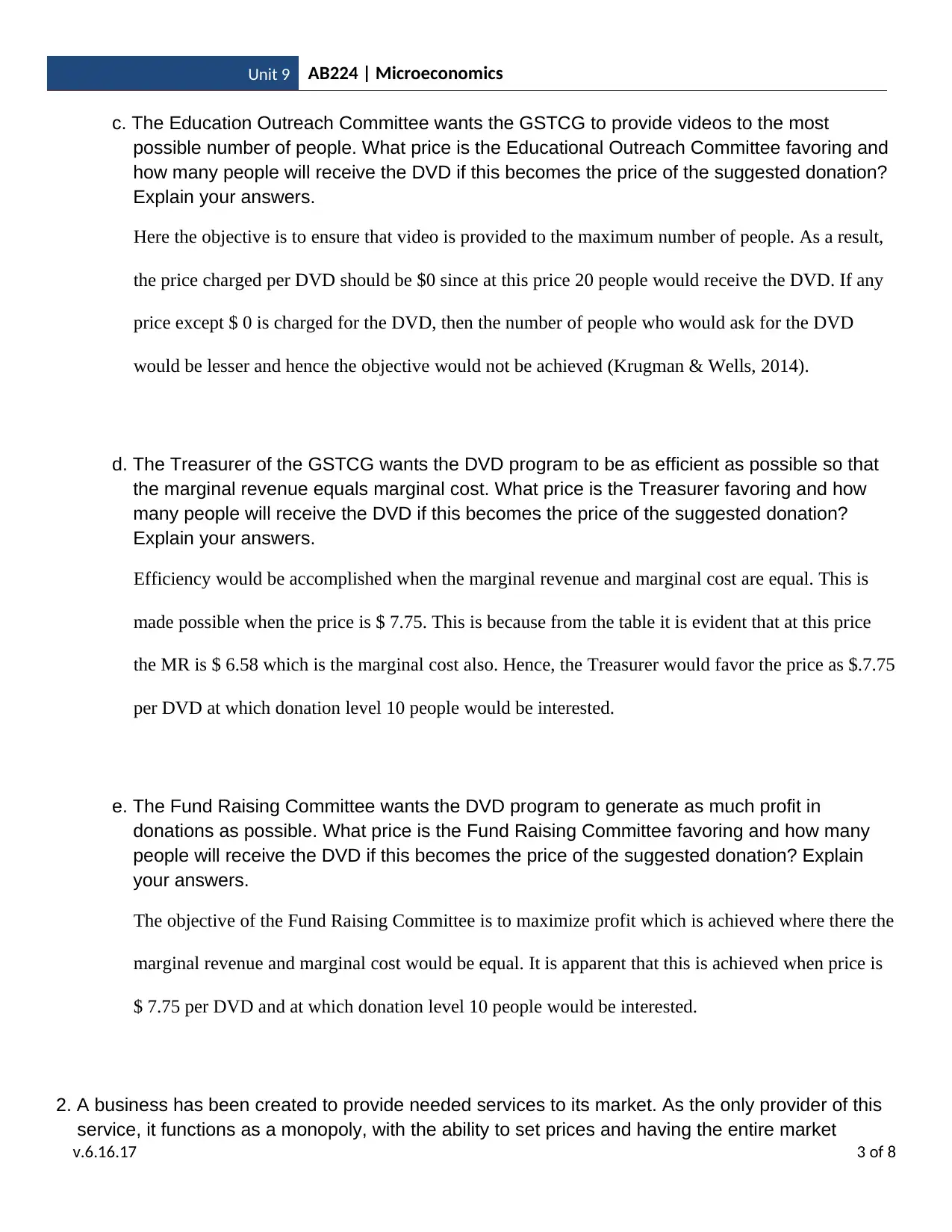
Unit 9 AB224 | Microeconomics
c. The Education Outreach Committee wants the GSTCG to provide videos to the most
possible number of people. What price is the Educational Outreach Committee favoring and
how many people will receive the DVD if this becomes the price of the suggested donation?
Explain your answers.
Here the objective is to ensure that video is provided to the maximum number of people. As a result,
the price charged per DVD should be $0 since at this price 20 people would receive the DVD. If any
price except $ 0 is charged for the DVD, then the number of people who would ask for the DVD
would be lesser and hence the objective would not be achieved (Krugman & Wells, 2014).
d. The Treasurer of the GSTCG wants the DVD program to be as efficient as possible so that
the marginal revenue equals marginal cost. What price is the Treasurer favoring and how
many people will receive the DVD if this becomes the price of the suggested donation?
Explain your answers.
Efficiency would be accomplished when the marginal revenue and marginal cost are equal. This is
made possible when the price is $ 7.75. This is because from the table it is evident that at this price
the MR is $ 6.58 which is the marginal cost also. Hence, the Treasurer would favor the price as $.7.75
per DVD at which donation level 10 people would be interested.
e. The Fund Raising Committee wants the DVD program to generate as much profit in
donations as possible. What price is the Fund Raising Committee favoring and how many
people will receive the DVD if this becomes the price of the suggested donation? Explain
your answers.
The objective of the Fund Raising Committee is to maximize profit which is achieved where there the
marginal revenue and marginal cost would be equal. It is apparent that this is achieved when price is
$ 7.75 per DVD and at which donation level 10 people would be interested.
2. A business has been created to provide needed services to its market. As the only provider of this
service, it functions as a monopoly, with the ability to set prices and having the entire market
v.6.16.17 3 of 8
c. The Education Outreach Committee wants the GSTCG to provide videos to the most
possible number of people. What price is the Educational Outreach Committee favoring and
how many people will receive the DVD if this becomes the price of the suggested donation?
Explain your answers.
Here the objective is to ensure that video is provided to the maximum number of people. As a result,
the price charged per DVD should be $0 since at this price 20 people would receive the DVD. If any
price except $ 0 is charged for the DVD, then the number of people who would ask for the DVD
would be lesser and hence the objective would not be achieved (Krugman & Wells, 2014).
d. The Treasurer of the GSTCG wants the DVD program to be as efficient as possible so that
the marginal revenue equals marginal cost. What price is the Treasurer favoring and how
many people will receive the DVD if this becomes the price of the suggested donation?
Explain your answers.
Efficiency would be accomplished when the marginal revenue and marginal cost are equal. This is
made possible when the price is $ 7.75. This is because from the table it is evident that at this price
the MR is $ 6.58 which is the marginal cost also. Hence, the Treasurer would favor the price as $.7.75
per DVD at which donation level 10 people would be interested.
e. The Fund Raising Committee wants the DVD program to generate as much profit in
donations as possible. What price is the Fund Raising Committee favoring and how many
people will receive the DVD if this becomes the price of the suggested donation? Explain
your answers.
The objective of the Fund Raising Committee is to maximize profit which is achieved where there the
marginal revenue and marginal cost would be equal. It is apparent that this is achieved when price is
$ 7.75 per DVD and at which donation level 10 people would be interested.
2. A business has been created to provide needed services to its market. As the only provider of this
service, it functions as a monopoly, with the ability to set prices and having the entire market
v.6.16.17 3 of 8
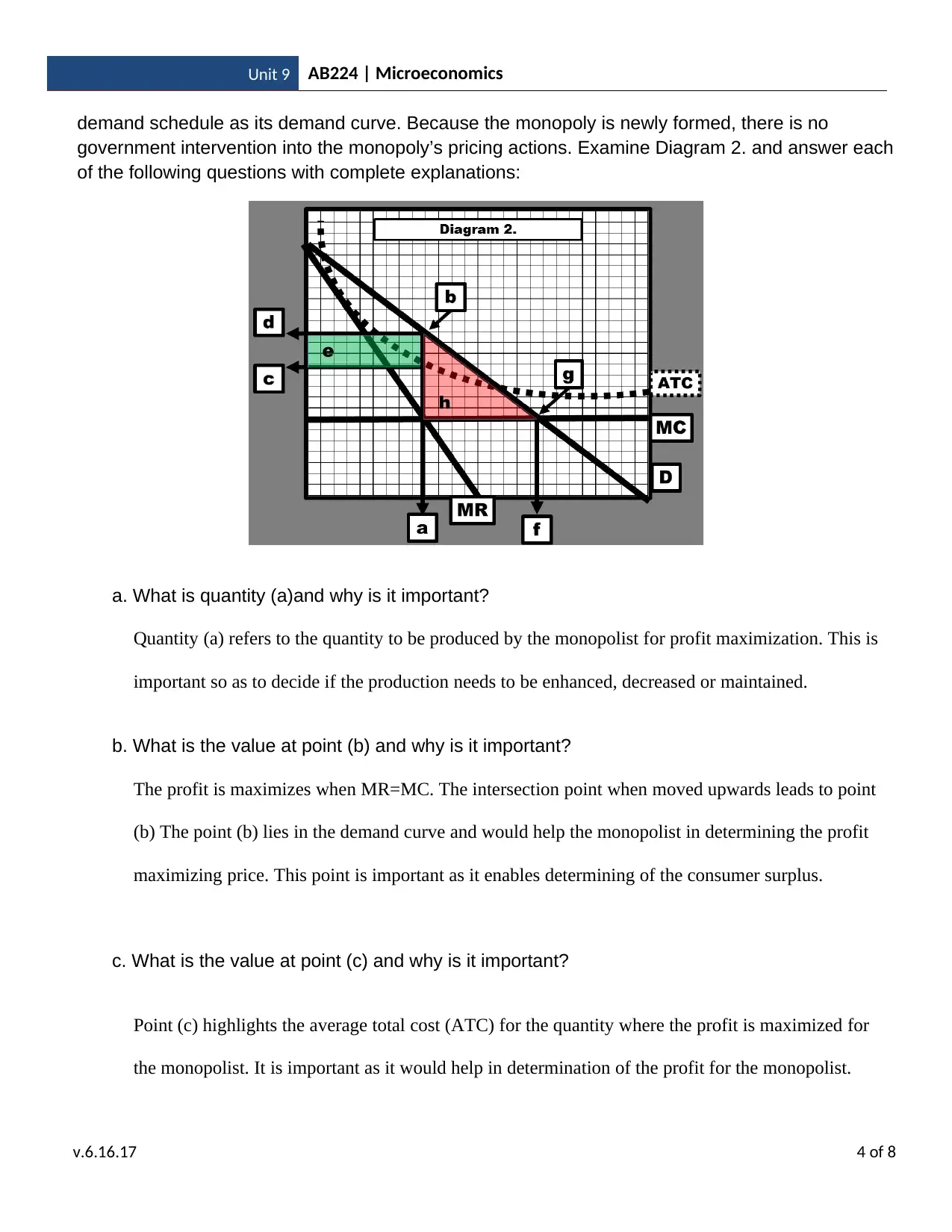
Unit 9 AB224 | Microeconomics
demand schedule as its demand curve. Because the monopoly is newly formed, there is no
government intervention into the monopoly’s pricing actions. Examine Diagram 2. and answer each
of the following questions with complete explanations:
a. What is quantity (a)and why is it important?
Quantity (a) refers to the quantity to be produced by the monopolist for profit maximization. This is
important so as to decide if the production needs to be enhanced, decreased or maintained.
b. What is the value at point (b) and why is it important?
The profit is maximizes when MR=MC. The intersection point when moved upwards leads to point
(b) The point (b) lies in the demand curve and would help the monopolist in determining the profit
maximizing price. This point is important as it enables determining of the consumer surplus.
c. What is the value at point (c) and why is it important?
Point (c) highlights the average total cost (ATC) for the quantity where the profit is maximized for
the monopolist. It is important as it would help in determination of the profit for the monopolist.
v.6.16.17 4 of 8
demand schedule as its demand curve. Because the monopoly is newly formed, there is no
government intervention into the monopoly’s pricing actions. Examine Diagram 2. and answer each
of the following questions with complete explanations:
a. What is quantity (a)and why is it important?
Quantity (a) refers to the quantity to be produced by the monopolist for profit maximization. This is
important so as to decide if the production needs to be enhanced, decreased or maintained.
b. What is the value at point (b) and why is it important?
The profit is maximizes when MR=MC. The intersection point when moved upwards leads to point
(b) The point (b) lies in the demand curve and would help the monopolist in determining the profit
maximizing price. This point is important as it enables determining of the consumer surplus.
c. What is the value at point (c) and why is it important?
Point (c) highlights the average total cost (ATC) for the quantity where the profit is maximized for
the monopolist. It is important as it would help in determination of the profit for the monopolist.
v.6.16.17 4 of 8
Secure Best Marks with AI Grader
Need help grading? Try our AI Grader for instant feedback on your assignments.
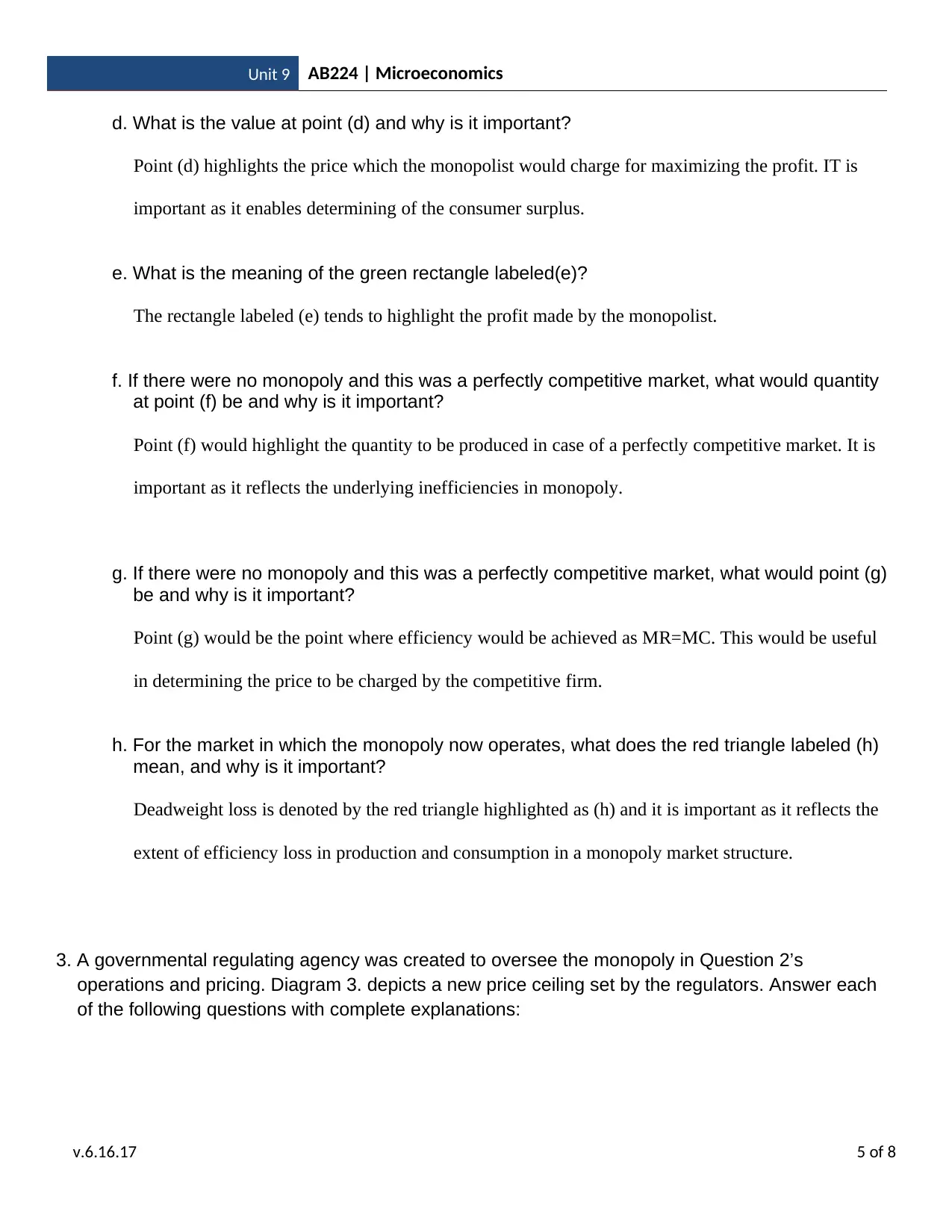
Unit 9 AB224 | Microeconomics
d. What is the value at point (d) and why is it important?
Point (d) highlights the price which the monopolist would charge for maximizing the profit. IT is
important as it enables determining of the consumer surplus.
e. What is the meaning of the green rectangle labeled(e)?
The rectangle labeled (e) tends to highlight the profit made by the monopolist.
f. If there were no monopoly and this was a perfectly competitive market, what would quantity
at point (f) be and why is it important?
Point (f) would highlight the quantity to be produced in case of a perfectly competitive market. It is
important as it reflects the underlying inefficiencies in monopoly.
g. If there were no monopoly and this was a perfectly competitive market, what would point (g)
be and why is it important?
Point (g) would be the point where efficiency would be achieved as MR=MC. This would be useful
in determining the price to be charged by the competitive firm.
h. For the market in which the monopoly now operates, what does the red triangle labeled (h)
mean, and why is it important?
Deadweight loss is denoted by the red triangle highlighted as (h) and it is important as it reflects the
extent of efficiency loss in production and consumption in a monopoly market structure.
3. A governmental regulating agency was created to oversee the monopoly in Question 2’s
operations and pricing. Diagram 3. depicts a new price ceiling set by the regulators. Answer each
of the following questions with complete explanations:
v.6.16.17 5 of 8
d. What is the value at point (d) and why is it important?
Point (d) highlights the price which the monopolist would charge for maximizing the profit. IT is
important as it enables determining of the consumer surplus.
e. What is the meaning of the green rectangle labeled(e)?
The rectangle labeled (e) tends to highlight the profit made by the monopolist.
f. If there were no monopoly and this was a perfectly competitive market, what would quantity
at point (f) be and why is it important?
Point (f) would highlight the quantity to be produced in case of a perfectly competitive market. It is
important as it reflects the underlying inefficiencies in monopoly.
g. If there were no monopoly and this was a perfectly competitive market, what would point (g)
be and why is it important?
Point (g) would be the point where efficiency would be achieved as MR=MC. This would be useful
in determining the price to be charged by the competitive firm.
h. For the market in which the monopoly now operates, what does the red triangle labeled (h)
mean, and why is it important?
Deadweight loss is denoted by the red triangle highlighted as (h) and it is important as it reflects the
extent of efficiency loss in production and consumption in a monopoly market structure.
3. A governmental regulating agency was created to oversee the monopoly in Question 2’s
operations and pricing. Diagram 3. depicts a new price ceiling set by the regulators. Answer each
of the following questions with complete explanations:
v.6.16.17 5 of 8
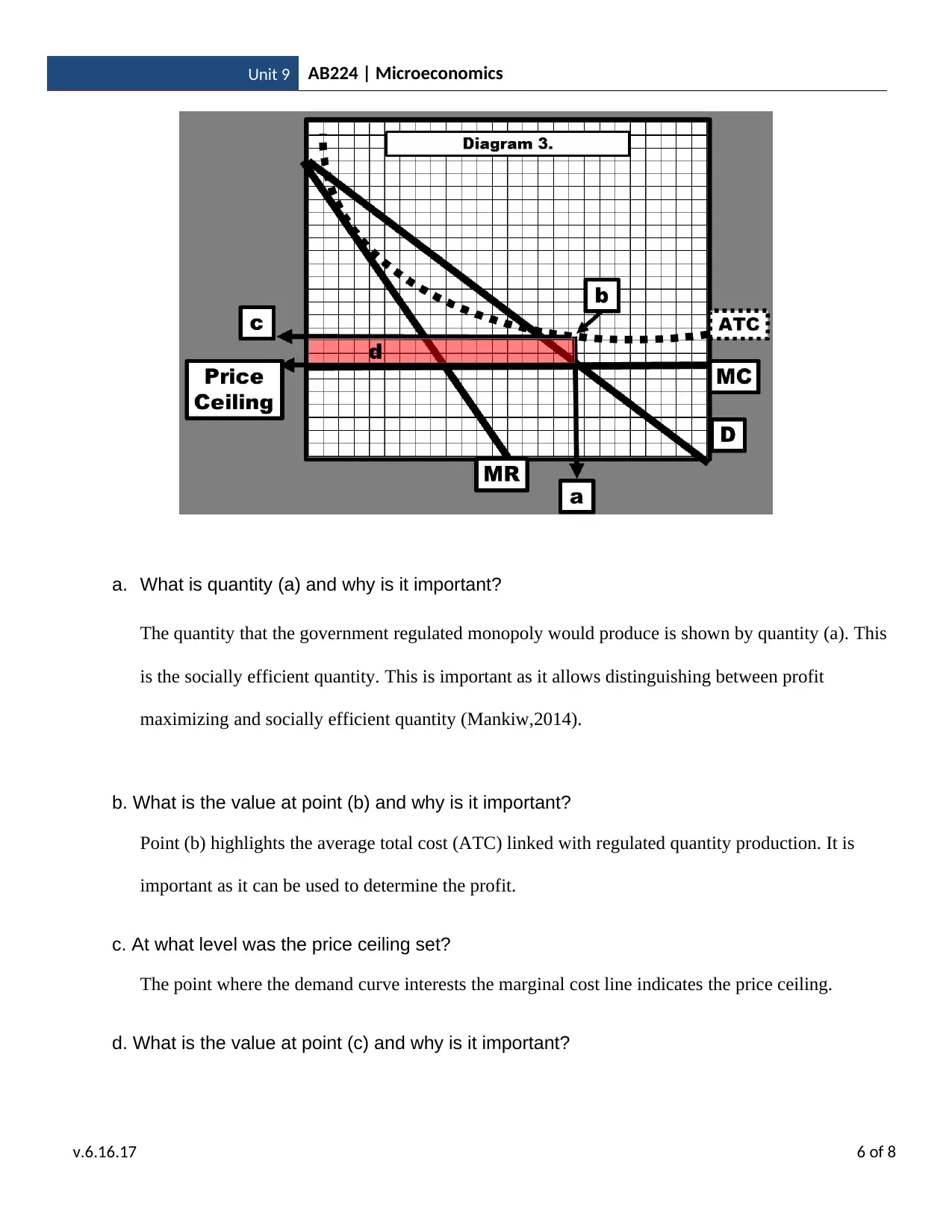
Unit 9 AB224 | Microeconomics
a. What is quantity (a) and why is it important?
The quantity that the government regulated monopoly would produce is shown by quantity (a). This
is the socially efficient quantity. This is important as it allows distinguishing between profit
maximizing and socially efficient quantity (Mankiw,2014).
b. What is the value at point (b) and why is it important?
Point (b) highlights the average total cost (ATC) linked with regulated quantity production. It is
important as it can be used to determine the profit.
c. At what level was the price ceiling set?
The point where the demand curve interests the marginal cost line indicates the price ceiling.
d. What is the value at point (c) and why is it important?
v.6.16.17 6 of 8
a. What is quantity (a) and why is it important?
The quantity that the government regulated monopoly would produce is shown by quantity (a). This
is the socially efficient quantity. This is important as it allows distinguishing between profit
maximizing and socially efficient quantity (Mankiw,2014).
b. What is the value at point (b) and why is it important?
Point (b) highlights the average total cost (ATC) linked with regulated quantity production. It is
important as it can be used to determine the profit.
c. At what level was the price ceiling set?
The point where the demand curve interests the marginal cost line indicates the price ceiling.
d. What is the value at point (c) and why is it important?
v.6.16.17 6 of 8
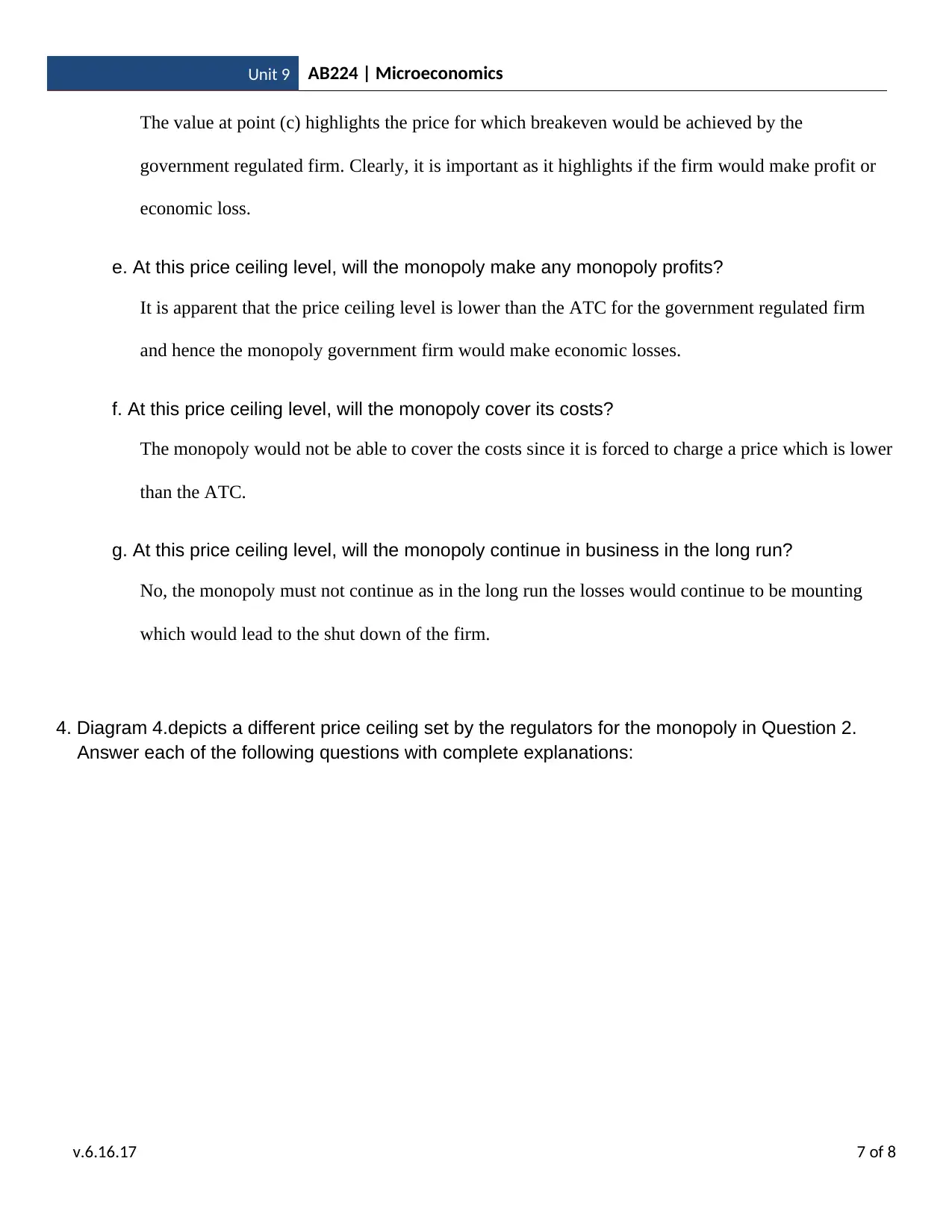
Unit 9 AB224 | Microeconomics
The value at point (c) highlights the price for which breakeven would be achieved by the
government regulated firm. Clearly, it is important as it highlights if the firm would make profit or
economic loss.
e. At this price ceiling level, will the monopoly make any monopoly profits?
It is apparent that the price ceiling level is lower than the ATC for the government regulated firm
and hence the monopoly government firm would make economic losses.
f. At this price ceiling level, will the monopoly cover its costs?
The monopoly would not be able to cover the costs since it is forced to charge a price which is lower
than the ATC.
g. At this price ceiling level, will the monopoly continue in business in the long run?
No, the monopoly must not continue as in the long run the losses would continue to be mounting
which would lead to the shut down of the firm.
4. Diagram 4.depicts a different price ceiling set by the regulators for the monopoly in Question 2.
Answer each of the following questions with complete explanations:
v.6.16.17 7 of 8
The value at point (c) highlights the price for which breakeven would be achieved by the
government regulated firm. Clearly, it is important as it highlights if the firm would make profit or
economic loss.
e. At this price ceiling level, will the monopoly make any monopoly profits?
It is apparent that the price ceiling level is lower than the ATC for the government regulated firm
and hence the monopoly government firm would make economic losses.
f. At this price ceiling level, will the monopoly cover its costs?
The monopoly would not be able to cover the costs since it is forced to charge a price which is lower
than the ATC.
g. At this price ceiling level, will the monopoly continue in business in the long run?
No, the monopoly must not continue as in the long run the losses would continue to be mounting
which would lead to the shut down of the firm.
4. Diagram 4.depicts a different price ceiling set by the regulators for the monopoly in Question 2.
Answer each of the following questions with complete explanations:
v.6.16.17 7 of 8
Paraphrase This Document
Need a fresh take? Get an instant paraphrase of this document with our AI Paraphraser

Unit 9 AB224 | Microeconomics
a.What is quantity (a) and why is it important?
The quantity demanded at the price ceiling is represented by quantity (a). It is significant to determine
the quantity demanded when the price is equal to the ceiling price.
b.What is the value at point (b)and why is it important?
The point (b) highlights the equilibrium point in presence of price ceiling. It is pivotal as it
determines the equilibrium quantity when price ceiling is applicable.
c. At what level was the price ceiling set?
The price ceiling is set at the price corresponding to the point (b) where there is intersection of
demand curve and ATC curve.
d. At this price ceiling level, will the monopoly make any monopoly profits?
The monopoly would not make any profits since at the equilibrium point (b), the ATC and price are
equal resulting in break even.
v.6.16.17 8 of 8
a.What is quantity (a) and why is it important?
The quantity demanded at the price ceiling is represented by quantity (a). It is significant to determine
the quantity demanded when the price is equal to the ceiling price.
b.What is the value at point (b)and why is it important?
The point (b) highlights the equilibrium point in presence of price ceiling. It is pivotal as it
determines the equilibrium quantity when price ceiling is applicable.
c. At what level was the price ceiling set?
The price ceiling is set at the price corresponding to the point (b) where there is intersection of
demand curve and ATC curve.
d. At this price ceiling level, will the monopoly make any monopoly profits?
The monopoly would not make any profits since at the equilibrium point (b), the ATC and price are
equal resulting in break even.
v.6.16.17 8 of 8
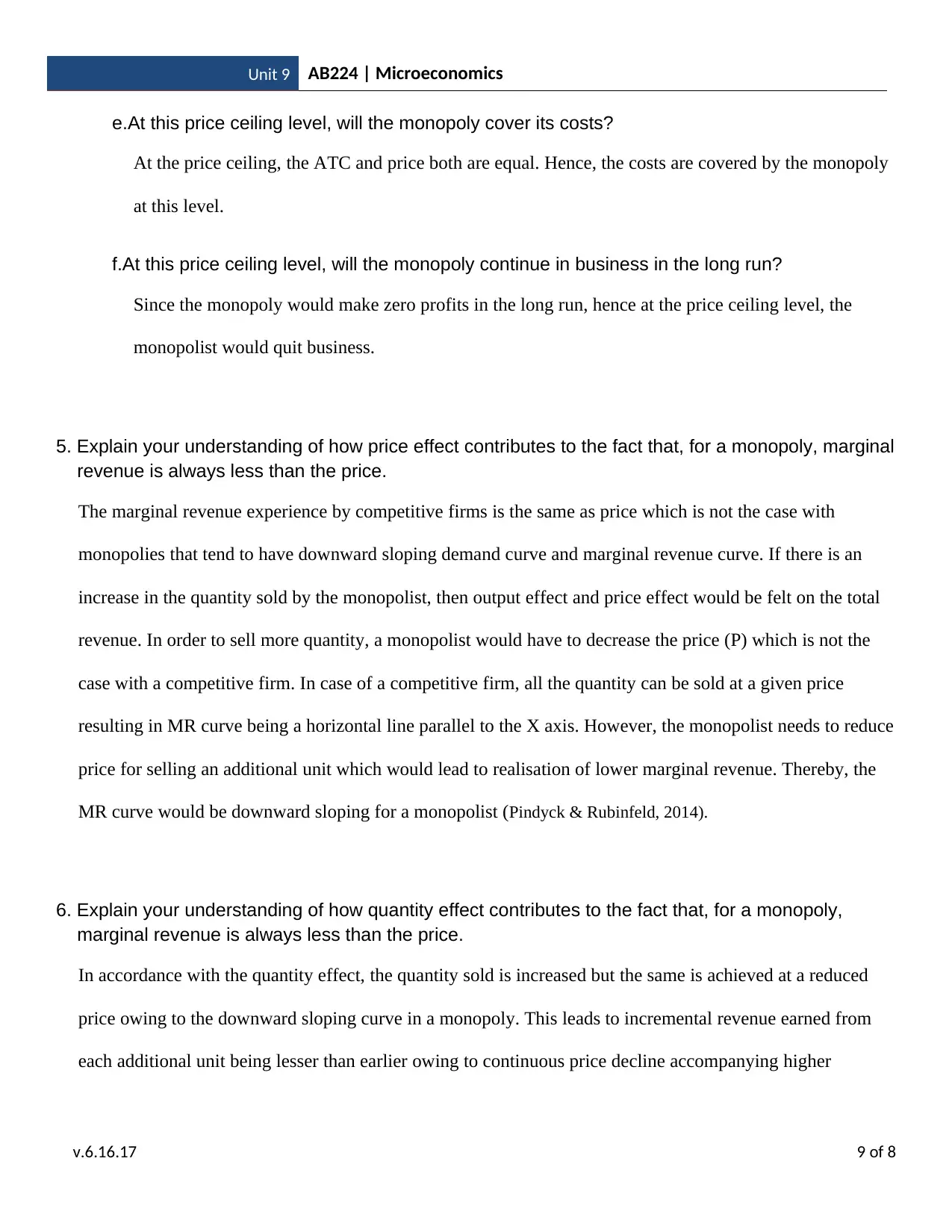
Unit 9 AB224 | Microeconomics
e.At this price ceiling level, will the monopoly cover its costs?
At the price ceiling, the ATC and price both are equal. Hence, the costs are covered by the monopoly
at this level.
f.At this price ceiling level, will the monopoly continue in business in the long run?
Since the monopoly would make zero profits in the long run, hence at the price ceiling level, the
monopolist would quit business.
5. Explain your understanding of how price effect contributes to the fact that, for a monopoly, marginal
revenue is always less than the price.
The marginal revenue experience by competitive firms is the same as price which is not the case with
monopolies that tend to have downward sloping demand curve and marginal revenue curve. If there is an
increase in the quantity sold by the monopolist, then output effect and price effect would be felt on the total
revenue. In order to sell more quantity, a monopolist would have to decrease the price (P) which is not the
case with a competitive firm. In case of a competitive firm, all the quantity can be sold at a given price
resulting in MR curve being a horizontal line parallel to the X axis. However, the monopolist needs to reduce
price for selling an additional unit which would lead to realisation of lower marginal revenue. Thereby, the
MR curve would be downward sloping for a monopolist (Pindyck & Rubinfeld, 2014).
6. Explain your understanding of how quantity effect contributes to the fact that, for a monopoly,
marginal revenue is always less than the price.
In accordance with the quantity effect, the quantity sold is increased but the same is achieved at a reduced
price owing to the downward sloping curve in a monopoly. This leads to incremental revenue earned from
each additional unit being lesser than earlier owing to continuous price decline accompanying higher
v.6.16.17 9 of 8
e.At this price ceiling level, will the monopoly cover its costs?
At the price ceiling, the ATC and price both are equal. Hence, the costs are covered by the monopoly
at this level.
f.At this price ceiling level, will the monopoly continue in business in the long run?
Since the monopoly would make zero profits in the long run, hence at the price ceiling level, the
monopolist would quit business.
5. Explain your understanding of how price effect contributes to the fact that, for a monopoly, marginal
revenue is always less than the price.
The marginal revenue experience by competitive firms is the same as price which is not the case with
monopolies that tend to have downward sloping demand curve and marginal revenue curve. If there is an
increase in the quantity sold by the monopolist, then output effect and price effect would be felt on the total
revenue. In order to sell more quantity, a monopolist would have to decrease the price (P) which is not the
case with a competitive firm. In case of a competitive firm, all the quantity can be sold at a given price
resulting in MR curve being a horizontal line parallel to the X axis. However, the monopolist needs to reduce
price for selling an additional unit which would lead to realisation of lower marginal revenue. Thereby, the
MR curve would be downward sloping for a monopolist (Pindyck & Rubinfeld, 2014).
6. Explain your understanding of how quantity effect contributes to the fact that, for a monopoly,
marginal revenue is always less than the price.
In accordance with the quantity effect, the quantity sold is increased but the same is achieved at a reduced
price owing to the downward sloping curve in a monopoly. This leads to incremental revenue earned from
each additional unit being lesser than earlier owing to continuous price decline accompanying higher
v.6.16.17 9 of 8

Unit 9 AB224 | Microeconomics
quantity sales. This typically results in decreasing marginal revenue which is reflected in the download
sloping MR curve (Nicholson & Snyder, 2015).
-------------------------------
References:
Krugman, P. & Wells, R. (2014).Microeconomics (2nded.). London: Worth Publishers.
Mankiw, G. (2014) Microeconomics (6thed.). London: Worth Publishers.
Nicholson, W. & Snyder, C. (2015).Fundamentals of Microeconomics (11thed.). New York: Cengage Learning.
Pindyck, R. & Rubinfeld, D. (2014).Microeconomics (5th ed.). London: Prentice-Hall Publications.
v.6.16.17 10 of 8
quantity sales. This typically results in decreasing marginal revenue which is reflected in the download
sloping MR curve (Nicholson & Snyder, 2015).
-------------------------------
References:
Krugman, P. & Wells, R. (2014).Microeconomics (2nded.). London: Worth Publishers.
Mankiw, G. (2014) Microeconomics (6thed.). London: Worth Publishers.
Nicholson, W. & Snyder, C. (2015).Fundamentals of Microeconomics (11thed.). New York: Cengage Learning.
Pindyck, R. & Rubinfeld, D. (2014).Microeconomics (5th ed.). London: Prentice-Hall Publications.
v.6.16.17 10 of 8
Secure Best Marks with AI Grader
Need help grading? Try our AI Grader for instant feedback on your assignments.
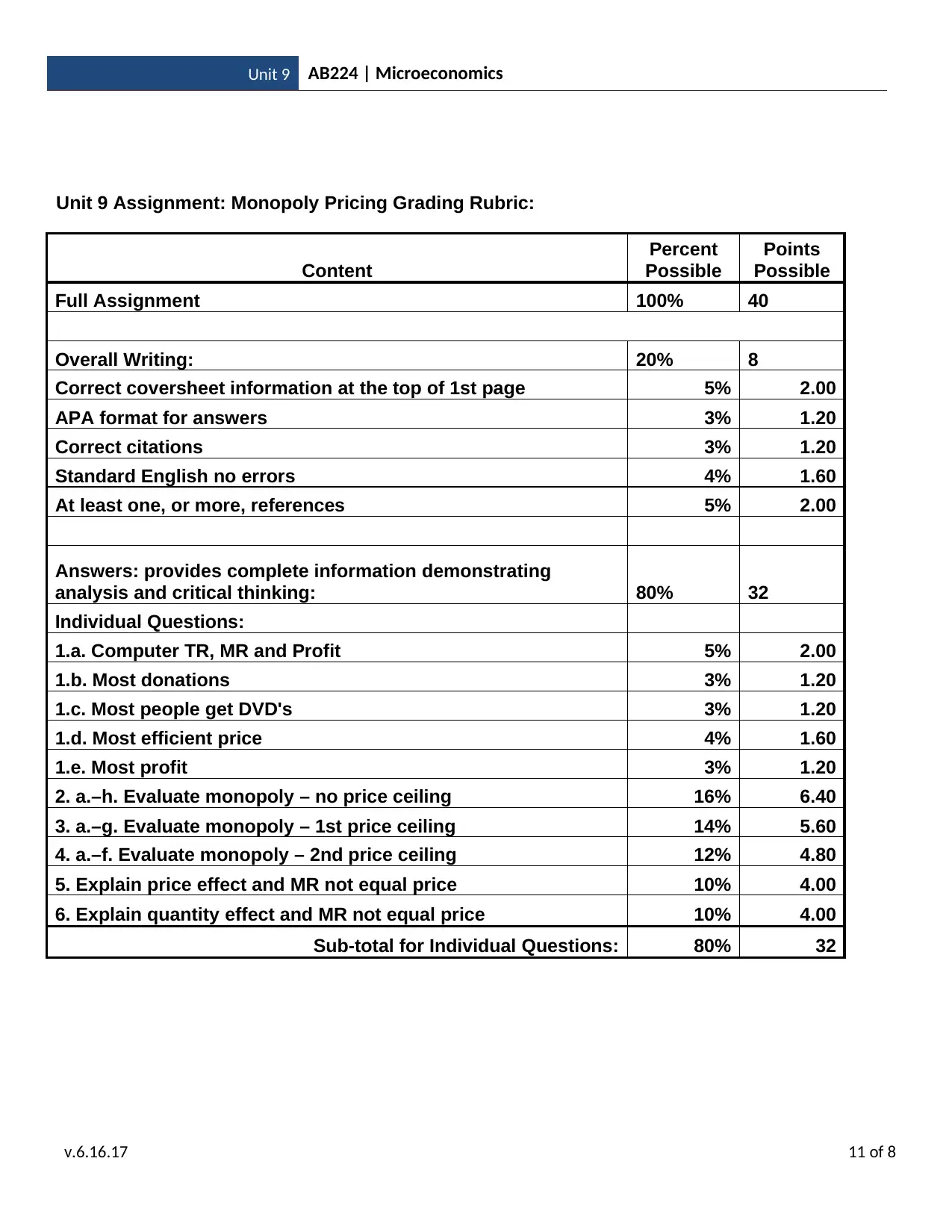
Unit 9 AB224 | Microeconomics
Unit 9 Assignment: Monopoly Pricing Grading Rubric:
Content
Percent
Possible
Points
Possible
Full Assignment 100% 40
Overall Writing: 20% 8
Correct coversheet information at the top of 1st page 5% 2.00
APA format for answers 3% 1.20
Correct citations 3% 1.20
Standard English no errors 4% 1.60
At least one, or more, references 5% 2.00
Answers: provides complete information demonstrating
analysis and critical thinking: 80% 32
Individual Questions:
1.a. Computer TR, MR and Profit 5% 2.00
1.b. Most donations 3% 1.20
1.c. Most people get DVD's 3% 1.20
1.d. Most efficient price 4% 1.60
1.e. Most profit 3% 1.20
2. a.–h. Evaluate monopoly – no price ceiling 16% 6.40
3. a.–g. Evaluate monopoly – 1st price ceiling 14% 5.60
4. a.–f. Evaluate monopoly – 2nd price ceiling 12% 4.80
5. Explain price effect and MR not equal price 10% 4.00
6. Explain quantity effect and MR not equal price 10% 4.00
Sub-total for Individual Questions: 80% 32
v.6.16.17 11 of 8
Unit 9 Assignment: Monopoly Pricing Grading Rubric:
Content
Percent
Possible
Points
Possible
Full Assignment 100% 40
Overall Writing: 20% 8
Correct coversheet information at the top of 1st page 5% 2.00
APA format for answers 3% 1.20
Correct citations 3% 1.20
Standard English no errors 4% 1.60
At least one, or more, references 5% 2.00
Answers: provides complete information demonstrating
analysis and critical thinking: 80% 32
Individual Questions:
1.a. Computer TR, MR and Profit 5% 2.00
1.b. Most donations 3% 1.20
1.c. Most people get DVD's 3% 1.20
1.d. Most efficient price 4% 1.60
1.e. Most profit 3% 1.20
2. a.–h. Evaluate monopoly – no price ceiling 16% 6.40
3. a.–g. Evaluate monopoly – 1st price ceiling 14% 5.60
4. a.–f. Evaluate monopoly – 2nd price ceiling 12% 4.80
5. Explain price effect and MR not equal price 10% 4.00
6. Explain quantity effect and MR not equal price 10% 4.00
Sub-total for Individual Questions: 80% 32
v.6.16.17 11 of 8
1 out of 11
Your All-in-One AI-Powered Toolkit for Academic Success.
+13062052269
info@desklib.com
Available 24*7 on WhatsApp / Email
![[object Object]](/_next/static/media/star-bottom.7253800d.svg)
Unlock your academic potential
© 2024 | Zucol Services PVT LTD | All rights reserved.